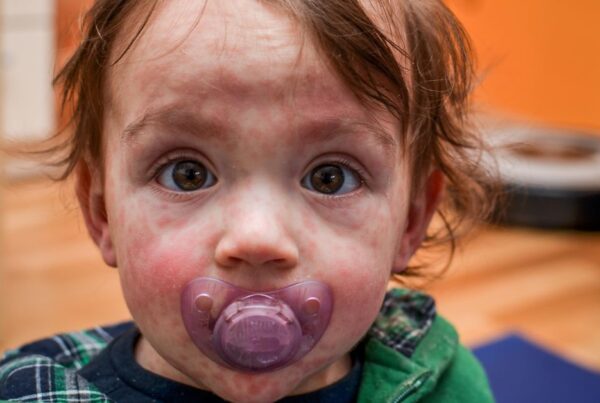We’ve all been guilty of enjoying a beautiful summer day outside, soaking up the sun with our kids, to later realize that everyone got a little too much sun made evident by our kids’ red arms and faces. First, I want you to release the guilt, mama. These things happen. Your kids had a wonderful day full of summer fun in the sun! Second, I want to share with you this simple and soothing DIY After-Sun Spray for quick sunburn relief. With the healing properties of aloe vera juice, antioxidant-rich green tea, and nourishing vitamin E oil, this home remedy for sunburns will become your go-to solution for after-sun skin care.
Why Your Skin Needs After-Sun Care
Before we dive into how to make the DIY After-Sun Spray, let’s take a moment to understand why our skin requires extra attention after soaking up the sun. As much as the sun provides us with incredible benefits for mood, circadian rhythm, vitamin D production (1), and disease prevention (2), prolonged exposure to ultraviolet (UV) radiation from the sun can also lead to sunburns, skin damage, and DNA damage (3), as well as dehydration. The best way to evade the negative effects of sun exposure is to avoid excessive sun exposure between the hours of 12-3 P.M. and to cover up with clothing and clean sunscreen as needed.
How To Safely Increase Sun Exposure
It is wise to slowly build up your sun exposure through consistent daily exposure to the sun in 5-30 minute intervals. Research shows that this gradual approach reduces the risk of damage from the sun (1). If your skin feels sore or is red after a day out in the sun, proper after sun care can help soothe and repair the skin, minimizing discomfort and promoting healing.
Topical Ingredients That Accelerate Healing
My DIY After-Sun Spray has amazing ingredients that accelerate healing. For example, aloe vera juice is packed with healing properties; green tea is antioxidant rich; and vitamin E oil is extremely nourishing. This home remedy for sunburns will quickly become your go-to solution for after-sun skin care!
Aloe Vera Juice: Soothe and Heal
Aloe vera has been cherished for centuries for its skin-soothing and healing properties. This clear, gel-like substance, found inside the leaves of the aloe vera plant, contains vitamins, minerals, and antioxidants that aid in skin repair and hydration (4). When applied topically, aloe vera juice can reduce inflammation, alleviate (sun)burn symptoms, and accelerate the skin’s healing process (5). It’s a natural and gentle solution for replenishing your skin after a day in the sun. Aloe Vera juice is available at most grocery stores, which makes this an accessible remedy.
Green Tea: A Potent Antioxidant
Green tea boasts powerful antioxidant compounds, such as catechins and polyphenols. These antioxidants help combat free radicals (5) such as those caused by UV exposure, protecting from oxidative stress. Additionally, green tea possesses anti-inflammatory and anti-erythema (6) properties, making it an excellent addition to an after sun spray to calm and cool irritated skin.
Vitamin E Oil: Nourish and Repair
Vitamin E is a fat-soluble antioxidant that plays a crucial role in maintaining skin health. When applied topically, vitamin E oil can nourish and moisturize the skin, helping to restore its natural barrier and reduce moisture loss. It can also assist in repairing burned skin (7).
Chamomile Essential Oil: Calm and Heal
Chamomile essential oil has been shown in studies to be anti-inflammatory and anti-microbial and to have antioxidant effects. A study on rats showed that a combination of olive oil and chamomile extract healed skin burns significantly quicker than olive oil alone (8). In another study, chamomile was shown to heal skin lesions in rats faster than corticosteroids (9). The aromatherapy benefits of chamomile essential oil are also significant. A study done with burn victims showed that an aromatherapy massage with chamomile and lavender oils had a significant impact on the anxiety levels and quality of sleep of this patient group (10).
Colloidal Silver: A Natural Antimicrobial
Colloidal silver has been used for its antimicrobial properties for centuries. While not a direct sunburn remedy, this addition is beneficial in preventing infections (11) in sunburned skin. By applying colloidal silver topically, its antibacterial properties may help protect the damaged skin from potential infections and promote a cleaner healing process.
Dr. Green Mom’s DIY After-Sun Spray
The vitamin E oil and the chamomile essential oil used in this spray will rise to the top when the spray settles, so gently shake the bottle before each use. Please note that this mixture may stain, so be cautious around clothing and furniture!
Ingredients
- 1/4 cup Aloe Vera Juice
- 1/4 cup Chilled Green Tea (brewed and cooled)
- 1 tablespoon Vitamin E Oil
- 1-3 drops of Chamomile Essential Oil
- 1 tsp of Colloidal Silver
Directions
- Brew a cup of green tea and let it cool in the refrigerator for about 30 minutes.
- In a small bowl or measuring cup, combine the chilled green tea and aloe vera juice.
- Add the vitamin E oil, drops of chamomile essential oil, and colloidal silver to the mixture.
- Carefully pour the mixture into a spray bottle and shake to combine.
If you don’t have a spray bottle on hand, you could also mix this up in a jar and use a cotton ball to dab the mixture onto the affected areas. This sunburn remedy will last in the fridge for 5-7 days. Keeping it in the fridge makes this spray cool and refreshing!
How Often Should I Apply After-Sun Spray?
This sun relief spray can be applied as often as needed. Discontinue use if irritation occurs. If you or your loved one are in a lot of pain, developing blisters, or experiencing signs of heat related illness, such as a fever, headache, rash, dehydration, nausea, chills, or confusion, it is important to seek medical care.
Follow Up With A Soothing Moisturizer
Sun exposure can be very drying to the skin, and this is even more true if the skin gets burned. While this spray has soothing and anti-inflammatory benefits, it won’t provide all the moisture your skin needs after sun exposure. I recommend applying a moisturizer, such as my Literally The Cleanest™ Moisturizing Body Lotion (With Botanical Hydraplex™) or Cleanest Care™ Nourishing Daily Lotion (With Botanical Calmplex™), which both contain Vitamin E oil, Aloe Vera Leaf Juice, and additional highly hydrating and soothing botanicals. Ideally, you’d apply the after-sun spray and then moisturize while the skin is still slightly damp to seal in all the goodness.
Additional Tips for After-Sun Care
- Be aware of the signs of dehydration and drink plenty of fluids to stay hydrated and help your skin recover from sun exposure.
- Avoid further sun exposure, especially during peak hours when the sun is at its strongest.
- Wear loose breathable clothing to prevent additional irritation on sun-exposed skin.
- Seek medical attention if your sunburn is severe or accompanied by blistering.
- Don’t hesitate to seek medical attention for babies under one year of age, as a sunburn can be more severe than it may seem.
Summary
Summer is a time of fun and adventure! I am a proponent of outdoor time for everyone. When it comes to sunburns, prevention is best but doesn’t always work. This DIY After-Sun Spray with aloe vera juice, chilled green tea, vitamin E oil, chamomile essential oil, and colloidal silver is a fantastic natural solution to soothe and nourish your skin after a day of fun in the sun!
References:
- Mead M. N. (2008). Benefits of sunlight: a bright spot for human health. Environmental health perspectives, 116(4), A160–A167. https://doi.org/10.1289/ehp.116-a160
- van der Rhee, H. J., de Vries, E., & Coebergh, J. W. (2016). Regular sun exposure benefits health. Medical hypotheses, 97, 34–37. https://doi.org/10.1016/j.mehy.2016.10.011
- Schuch, A. P., Moreno, N. C., Schuch, N. J., Menck, C. F. M., & Garcia, C. C. M. (2017). Sunlight damage to cellular DNA: Focus on oxidatively generated lesions. Free radical biology & medicine, 107, 110–124. https://doi.org/10.1016/j.freeradbiomed.2017.01.029
- Hekmatpou, D., Mehrabi, F., Rahzani, K., & Aminiyan, A. (2019). The Effect of Aloe Vera Clinical Trials on Prevention and Healing of Skin Wound: A Systematic Review. Iranian journal of medical sciences, 44(1), 1–9.
- Ohishi, T., Goto, S., Monira, P., Isemura, M., & Nakamura, Y. (2016). Anti-inflammatory Action of Green Tea. Anti-inflammatory & anti-allergy agents in medicinal chemistry, 15(2), 74–90. https://doi.org/10.2174/1871523015666160915154443
- Maenthaisong, R., Chaiyakunapruk, N., Niruntraporn, S., & Kongkaew, C. (2007). The efficacy of aloe vera used for burn wound healing: a systematic review. Burns : journal of the International Society for Burn Injuries, 33(6), 713–718. https://doi.org/10.1016/j.burns.2006.10.384
- Pereira, G. G., Guterres, S. S., Balducci, A. G., Colombo, P., & Sonvico, F. (2014). Polymeric films loaded with vitamin E and aloe vera for topical application in the treatment of burn wounds. BioMed research international, 2014, 641590. https://doi.org/10.1155/2014/641590
- Jarrahi M. (2008). An experimental study of the effects of Matricaria chamomilla extract on cutaneous burn wound healing in albino rats. Natural product research, 22(5), 422–427. https://doi.org/10.1080/14786410701591713
- Martins, M. D., Marques, M. M., Bussadori, S. K., Martins, M. A., Pavesi, V. C., Mesquita-Ferrari, R. A., & Fernandes, K. P. (2009). Comparative analysis between Chamomilla recutita and corticosteroids on wound healing. An in vitro and in vivo study. Phytotherapy research : PTR, 23(2), 274–278. https://doi.org/10.1002/ptr.2612
- Rafii, F., Ameri, F., Haghani, H., & Ghobadi, A. (2020). The effect of aromatherapy massage with lavender and chamomile oil on anxiety and sleep quality of patients with burns. Burns : journal of the International Society for Burn Injuries, 46(1), 164–171. https://doi.org/10.1016/j.burns.2019.02.017
- Jung, W. K., Koo, H. C., Kim, K. W., Shin, S., Kim, S. H., & Park, Y. H. (2008). Antibacterial activity and mechanism of action of the silver ion in Staphylococcus aureus and Escherichia coli. Applied and environmental microbiology, 74(7), 2171–2178. https://doi.org/10.1128/AEM.02001-07
Medical advice disclaimer: This content is strictly the opinion of Dr. Green Mom® and is for informational and educational purposes only. It is not intended to provide medical advice or to take the place of medical advice or treatment from a personal physician.


